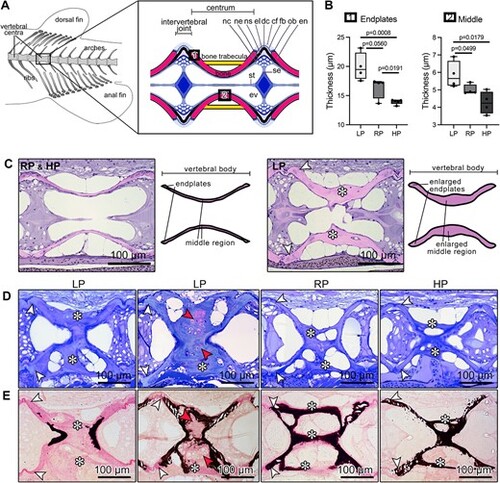Fig. 1
- ID
- ZDB-FIG-240724-6
- Publication
- Cotti et al., 2024 - Matrix first, minerals later: fine-tuned dietary phosphate increases bone formation in zebrafish
- Other Figures
- All Figure Page
- Back to All Figure Page
|
Bone formation increases and bone mineralization is arrested following LP diet. (A) Scheme of the vertebral column of an adult zebrafish indicating the location of the vertebral centra used for analysis. The box shows a schematic of the midline sagittal plane of a vertebral body centrum and two intervertebral joints. Osteoblasts (ob) deposit new bone matrix at the vertebral body endplates (en), i.e. the bone growth zones, which are connected by intervertebral ligaments. From inside to outside, the ligaments consist of the notochord sheath (ns, a collagen type II layer secreted by the cells of the notochord epithelium, ne), the outer elastin layer (el), and dense collagen type I fiber bundles (dc) produced by fibroblasts (fb). The collagen type I fiber bundles (cf) continue in the bone of the vertebral body endplates (en) as Sharpey fibers. The notochord is composed of vacuolated notochord cells (nc) and extracellular vacuoles (ev). Condensed notochord cells constitute the notochord septum (se) and the notochord strand (st). Boxes show locations where the bone thickness was measured, i.e. endplates (1) and middle region of the autocentrum (2). (B) Bone thickness measurements at vertebral endplates and middle region of the autocentrum from LP, RP, and HP animals aftertwo months of dietary treatment. LP zebrafish have thicker structures compared to RP and HP animals (see also Table S2). Values are reported with Box and Whisker plots: the midline in each box is indicative of the median, whereas min and max values are shown with whiskers. Individual data points and P values are shown. (C) Sagittal demineralized histological sections stained with elastin staining and schematics showing vertebral bodies from RP (representative also of HP) and LP animals. LP zebrafish have enlarged vertebral body endplates (white arrowheads) and middle region (asterisks) compared to RP and HP. (D) Toluidine blue stained sagittal sections of vertebral bodies from LP, RP, and HP show that vertebral endplates (white arrowheads) and trabecular bone (asterisks) are considerably thicker in LP animals in comparison with controls and HP fish. Red arrowheads show chondroid bone. (E) Von Kossa/Van Gieson stained non-demineralized sections show a similar sectional plane as in D. The additional bone formed under the LP diet conditions is mostly non-mineralized at vertebral endplates (white arrowheads) and trabecular bone (asterisks) compared to RP and HP. Non-mineralized bone: pink; mineralized bone: black. Some vertebral bodies from LP individuals present enlarged (asterisks) bone trabeculae characterized by the presence of chondroid bone (red arrowheads), which is largely non-mineralized as demonstrated by Von Kossa/Van Gieson staining. |

